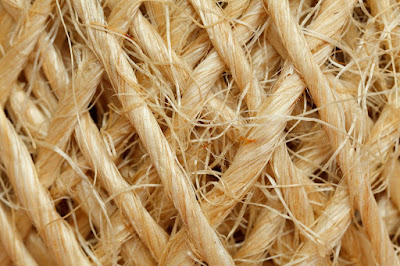Hemp
Fiber Processing
Yashashree Ingle
Department of Textile
Technology
Veermata Jijabai
Technological Institute, Mumbai, India
Retting:
Harvesting
of hemp fiber is carried out by means of a conventional combine harvester machine.The
hemp fiber usually consist of two types of fiber.
Long
outer fibers are used for textile and technical fabrics.
Short
inner fibers which are used for producing paper or other industrial
applications.
Once
the plants are cut, they are left in the field for 10-20 days so that they are
retted. Retting involves the removal of the substances that bind the fiber
to other constituents of the hemp stalk.
Generally retting is of 2 types:
- Water retting- In water retting the stems of hemp are kept in tanks, ponds or streams for around 10 days. It is noticed that the retting becomes more effective if water is warm.
- Dew retting- Dew retting is the natural process that is carried out when the dew falls on the crop each morning. After wetting, the hemp stems are laid parallel in rows to dew ret. The stems required turning at once occasionally so that the process is properly carried out.
Decortication:
Once
the hemp fiber is retted, the stalks are collected and then transferred to the ‘Decortication
machine’. In this process the deleafed hemp stems are dried. In other words,
this process involves the breaking of stems by passing them through ‘breaker’
or fluted rollers. Then the fiber is separated from the woody core ‘scothing’
by beating the broken stems by passing them through the rotary blades.
Softening and Combing:
After
the decortication, the hemp fiber are soften by using the softner or roller, the
decorticated fibers are made softer and suppler. Then combing is carried out,
it involves the shortening of the initial fiber lengths from upto 3 m down to 650 mm is done on a special
cutting machine.
Spinning of Hemp Fiber:
- Five drafts and doublings are required and after the passage of drafting and doubling, the manufacture slivers are pre spun roving yarns and according to the quality and the desired fineness, spun into hemp yarn by wet and dry spinning process.
- A hemp roving frame is similar to that of flax tow roving frame but somewhat heavy and large. The hemp is coarser than flax. So the pins of the board for drafting the combed fiber into a sliver are set differently.
- The rove produced is then boiled in caustic soda so that it is refined and most of the yarn is bleached with Hydrogen Peroxide.
- Hemp yarn is produced by both wet and dry spinning process, similar to that of Flax Spinning but generally the best yarns are obtained by wet spinning.
- Wet spinning involves passing the fibers through a trough of hot water before being spun. This process ensures that the pectins are softer which in turn allows the greater drawing out and separation of fibers and producing fiber yarns.
- Dry spinning on the other hand is cheaper producing yarns through the different appearance and handle, which is coarser compare to that of wet spun yarn.
- Using the above mentioned process 2 types of hemp yarn are produced namely long yarn and short yarn which has different application areas.
- Normally, the counts are 7/1 Nm , Nm 8.5/1 , Nm 10/1 , Nm 16/1 , Nm 18/1 , Nm 24/1 , Nm 36/1
- The above preparatory process of hemp fibers include considerable waste termed as the hurd.
- High hurd contain can be used as a part of blend to produce good quality yarn of this kind and the raw material usually used is tangled tow of different length, fineness.
- In short, long fiber spinning involves fiber softening, fiber cutting, hackling, drafting and doubling respectively.
- Short fiber spinning involves pre carding which prepares the fiber for carding, final carding which consist of feeder, card and draw head units and finally drawing and doubling.
Weaving- Current market scenario
The
quantity and variety of hemp fabric produced in the last decade has decreased
significantly. This is due to the following reason:
- Firstly the weaving companies either left the market or changed to other fibers. Secondly for example the demand for the hemp canvas, covers and sacks had decreased their users as the generally consumers have changed over fabric made from synthetic fibers which have better properties compared to that of hemp.
- Other factors that led to the decline in hemp fabric production were disappearance of wet spinning particularly in Hungary and the chemical separation of hemp fiber and deterioration in quality of both locally produced and imported hemp. Inspite, the substantial decrease in hemp woven production, Weaving for fabric and carpets remains the important outlets for hemp yarns.
Applications:
- Coarse hemp fibers and yarns are woven into cordage, rope, sacking, and heavy duty tarpaulins.
- In Italy, fine hemp fibers are used for interior design and apparel fabrics.
- Hemp is also used in manufacturing of tape stray, hats, shawls, rugs etc
- The dyed hemp yarn is suitable for rug weaving, place mats, crochets and another crafts items.
- Hemp is stronger than linen and jute fiber hence it is ideal for making twines, ropes, cables, canvas, sail cloth etc.
- Hemp also produces an oil seed that contains between 25 to 35% oil by weight , which is high in essential fatty acid considered to be necessary to maintain health
More Articles from this Author:






0 Comments